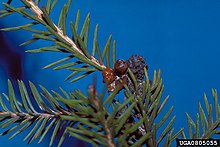Cup scale insects
| Cup scale insects | ||||||||||||
|---|---|---|---|---|---|---|---|---|---|---|---|---|

|
||||||||||||
| Systematics | ||||||||||||
|
||||||||||||
| Scientific name | ||||||||||||
| Coccidae | ||||||||||||
| Stephens , 1829 |

The cup scale insects (Coccidae) are a family of the scale insects (Coccoidea). About 1100 species are known worldwide, 146 species are native to Europe. They include economically important pests, for example from the genera Coccus , Ceroplastes , Lecantum , Saissetia , Parthenolecantum and Eulecantum , as well as some economically important species. For example, the spruce whisker scale insects ( Physokermes ) with their honeydew excretions provide the basis for forest honey .
features
As with other scale insects, males and females of cup scale insects differ significantly ( sexual dimorphism ). The females reach a body length of three to six, rarely more than nine millimeters and have a round to oval shaped, bowl to spherical body. The back is more or less arched upwards. In the adult females you can hardly see the body segments. The antennae and legs are thin and short, but seldom strongly receded. The labium is one-part. The thorax has two stigmas on each side . At the end of the abdomen there is an anal plate above the anal opening, which is covered by two additional plates. Only in the species of the spruce whisker scale insects are these plates only formed in the female nymphs , in the adult they are reduced. Unlike in the Stictococcidae, the anal opening of the animals is not far in front on the back of the first abdomen segment , but clearly further back. The body surface of the female has different glandular exits and pores depending on the species, the back is often covered with their excretions. On the sides there are usually thorns or bristles, between which there are often three stigma thorns at the level of the stigmas. The older the animals get, the more they are sclerotized .
The males have well developed forewings, their hind wings are receded, absent or reduced to swinging bulbs. Your antennae have 10 links. At the end of the abdomen, the males carry two long white wax threads.
Way of life
The females only go through two larval stages, the males four. The latter develop from the second stage under a boat-shaped, more or less transparent shield. Depending on the species, reproduction can take place parthenogenetically and / or together with the males. The stage of spread of the animals are the nymphs. They cannot fly, but they also use the wind as a means of transport. Once they have found a suitable place on a plant, they settle down and then move only rarely. They suck plant sap and excrete honeydew, through which they are sometimes associated with ants that eat it.
Types (selection)
- Small spruce whisker scale ( Physokermes hemicryphus )
- Great spruce whisker scale ( Physokermes piceae )
- Ceroplastes japonicus
- Saissetia coffeae
literature
Article base
- Hans Strümpel: Homoptera (plant teat). Manual of Zoology 4 (28) , Walter de Gruyter. Berlin, New York 1983, ISBN 3-11-008856-8
Individual evidence
Web links
Article base
- Brisbane Insects and Spiders Home Page ( September 3, 2007 memento in the Internet Archive )
general

